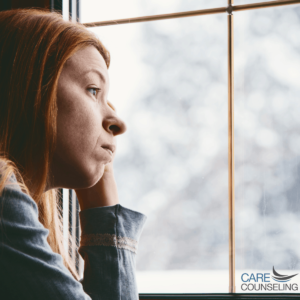SAD? Are you feeling tired, lacking energy, experiencing fatigue, and a loss of motivation? These are common in those with a seasonal pattern of depression.

Seasonal Affective Disorder (SAD) is viewed as a form of major depression. In addition to depressed mood and/ or decreased interest or pleasure activities. Additional symptoms often include a tendency to oversleep, difficulties concentrating, and irritability.
Seasonal affective disorder tends to begin in the fall (Sept/ Oct) and last through the spring (March/ April). January tends to be an especially difficult month for many individuals, exacerbated this year by the stressors of the pandemic.
A study by the Kaiser Family Foundation found that over half of the US adult population (53%) have reported negative mental health impacts due to COVID-19 related stress. The duration the pandemic, combined with the winter months have experts concerned winter-and-pandemic-stressors-could-be-double-whammy-for-mental-health. For those of us experiencing Minnesota winter where the days are shorter, the sun sets sooner, and the temps are frigid it can be harder to get outdoors and enjoy the sunshine.
• Did you know that for those with visual impairments, the risk of developing seasonal-affective-disorder is almost three times higher?
• Women are especially at risk, as 4 out of 5 people with SAD tend to be women.
• Susceptibility to seasonal depression may also be influenced by eye color due to the amount of light the eye can process and melatonin production. #Why-blue-eyes-keep-the-blues-away.
Changes in the amount of sunlight appear to trigger seasonal-affective-disorder. These changes may negatively impact one’s “biological clock” which controls sleep-wake patterns and disrupt the functions of neurotransmitters such as serotonin and dopamine. Serotonin helps regulate mood.
There are several theories about the causes of SAD. Research suggests nimh.nih.gov/health/publications sunlight is an important factor that aids in the maintenance of normal serotonin levels. For those with SAD, these are problems with regulation that result in decreased serotonin.
Melatonin production may be another factor as producing too much melatonin increases sleepiness. Melatonin is a hormone that is important in maintaining a regular sleep-wake schedule.
Low vitamin D levels could also be a factor as it is believed to promote serotonin and those with SAD tend to receive less vitamin D through exposure to sunlight.
One interesting thing that I recently learned from my optometrist is the connection between eye health and mental health. This is a friendly reminder that if you have not had a recent eye exam, now may be a good time to schedule one. It is also the perfect time to see a therapist!
SAD Treatments Include the Following:
- Increasing exposure to light during the winter
- Exercising outdoors
- Using light therapy such as a SAD lamp
- Psychotherapy
- Antidepressants
- Vitamin D
Written By: Charlotte Johnson MA, LPCC
We’re Here to help
Our wellness experts will be happy to take care of you. You can CLICK HERE to schedule an appointment now or call (612)223-8898.
Meet Clinicians
We’re united by our commitment to providing effective, relevant, and innovative mental health support at all stages of your journey. Click Here to find out more about who we are, where we come from, and how we live out CARE’s mission every day.
The professionals at CARE are actively collecting and creating resources to help with what you need. We’re Here for You.



